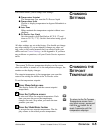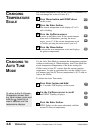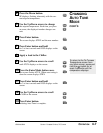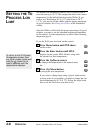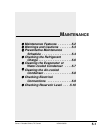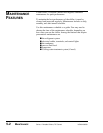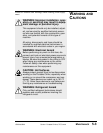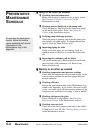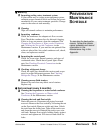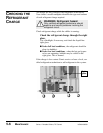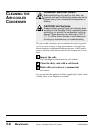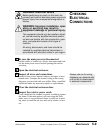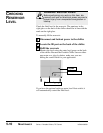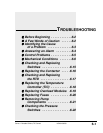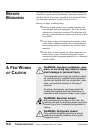
P
REVENTATIVE
MAINTENANCE
SCHEDULE
UGH016/0500 Series 1 Portable Chillers, TIC Control
MAINTENANCE 5-5
●●
Monthly
❒❒
Inspecting cooling water treatment system
If your chiller uses a cooling water treatment system,
maintain proper chemical levels and follow the recom-
mendations of your water treatment specialist. Change
water in the reservoir tank monthly.
❒❒
Cleaning
Wipe all external surfaces to maintain performance.
❒❒
Inspecting condenser
Check the condenser for adequate air flow or water
flow. Check the condenser face for dirt and clogging.
If dirt or clogs are present, clean the condenser. See
Cleaning the Evaporator or Water-cooled Condenser,
and Cleaning the Air-cooled Condenser, in the
Maintenance section. If your unit has an optional filter
at the air inlet of the Air-cooled condenser coil, check,
clean, and replace as needed.
❒❒
Inspecting the control panel
Check for loose wires, burned contacts, and signs of
overheated wires. Check that all panel lights illumi-
nate. See Checking Electrical Connections in the
Maintenance section.
❒❒
Checking refrigerant charge
Check the sight glass between the receiver and evapo-
rator for proper refrigerant pressure. See Checking
Refrigerant Charge, in the Maintenance section.
❒❒
Cleaning process fluid strainer
Remove cap and clean any debris out of strainer.
Replace cap.
●●
Semi-annual (every 6 months)
❒❒
Cleaning the evaporator or water-cooled condenser
See Cleaning the Evaporator or Water-cooled
Condenser, in the Maintenance section.
❒❒
Cleaning the tank and float switch
Drain the reservoir. Disconnect all piping from tank
reservoir. Remove the float switch by loosening the nut
on the float switch. Remove switch and clean. Unbolt
the tank from the chiller base. Take off the tank cover
and clean the reservoir. Reinstall the tank cover; rein-
stall tank. Reinsert float switch, holding firmly against
reservoir and tighten nut. Fill reservoir and check for
leaks.
To maintain the best perfor-
mance, follow the mainte-
nance schedule and record
information in the
Maintenance Log in the
Appendix.



